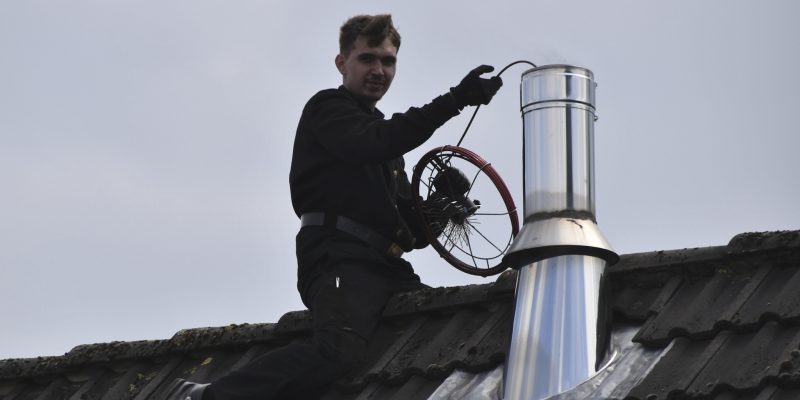A crackling fire in the hearth is one of life’s simple pleasures on a cold winter day. But without proper maintenance, your fireplace can transform from a cozy retreat into a hazardous health threat. Chimneys require regular care and cleaning to prevent dangerous buildup, deterioration, and ventilation issues over time.
Unfortunately, many homeowners neglect periodic chimney inspections and sweeping until problems arise.
You’ll learn chimney hazard prevention, signs it’s time to call a professional, maintenance tips, what to expect during a chimney sweep appointment, and how to choose a qualified chimney service company.
With this advice, you’ll understand how to maintain your chimney year-round properly. You’ll also discover why investing in regular professional cleanings is so important for your household’s health and safety. Let’s get started exploring the keys to safe chimney operation so you can confidently handle every aspect of chimney care for your most valuable investment in your home.
Hazards of Chimney Neglect
It’s easy to overlook your chimney until issues increase in smoke. But delaying maintenance can lead to dangerous problems, including:
Chimney Fires
Creosote, an oily byproduct of burned wood, coats the inside of flues over time. It’s highly combustible and the leading cause of chimney fires when allowed to build up. Prevent fires by having a chimney sweep in Massachusetts and remove creosote yearly or more often if needed.
Ventilation Issues
Blockages from debris, nests, or excess creosote can prevent proper ventilation. Smoke then billows back into living areas, which is both damaging and a serious health hazard. Keeping the flue cleared maintains air quality.
Pest Infestations
Raccoons, birds, squirrels, and other pests love the sheltered environment of chimneys. But they can get trapped inside, create noisy disturbances, and damage your home. Keeping animals out with a secure cap prevents problems.
Moisture Deterioration
Water and moisture erode masonry, which leads to crumbling bricks, cracks, missing mortar, and eventual structural instability without repair. Sealing the crown and cap minimizes dampness.
Carbon Monoxide Leaks
Improper ventilation allows odorless, poisonous carbon monoxide gas to leak into your home. Routine inspections verify your chimney is safely venting all gases outside.
Signs Your Chimney Needs a Sweep
Watch for these signs that it’s time to schedule a chimney inspection and maintenance:
- Visible creosote chunks or buildup
- Dark stains on exterior masonry
- Crumbling or missing bricks and mortar
- Smoky smell or excess smoke billowing out
- Lack of proper draft while burning
- Sounds of animals scratching or nesting
Do not delay at the first sign of trouble. Contact reputable sweeps right away before the issues worsen!
Chimney Maintenance Timelines
Most homeowners should aim for professional chimney cleanings at least once per year. However, ideal timelines vary based on:
- Use Frequency – Chimneys used daily or weekly need biannual or quarterly cleanings. At the same time, occasional use may only be required every 2-3 years.
- Wood Type – Softer woods create more creosote. Opt for medium or hardwoods like oak or maple to help extend the time between professional cleanings.
- Climate – Chimneys in colder, wetter regions accumulate creosote quicker than in mild environments. Evaluate your climate zone.
Discuss your specific use patterns with a reputable chimney pro to establish an optimal maintenance schedule.
Professional Chimney Sweep Process
When hiring sweeps, look for these steps:
Inspection
Initial inspection checks for creosote, blockages, moisture, and damage using cameras as needed.
Surface Preparation
Technicians cover surfaces with tarps and remove decorative covers to prep.
Scrubbing & Sweeping
Rotary brushes scrub interior surfaces while poles sweep away debris. Vacuums help safely remove residue.
Creosote Removal
All combustible creosote is fully removed and disposed of properly.
Final Inspection
Cameras check the flue system again, ensuring complete, thorough cleaning.
Exterior Work
The crown, cap, and exterior masonry get inspected and repaired as needed.
Capping
A screened cap is installed to keep out moisture and pests between cleanings.
Documentation
You receive full documentation detailing the work completed and the current chimney condition.
Questions to Ask Potential Sweepers
To choose the best pro, ask:
- Are you certified by the Chimney Safety Institute of America (CSIA)?
- Do you have liability insurance and workers’ compensation?
- What specific tools and methods do you use?
- Do you offer repair services or just sweeping?
- Can you provide before/after photos or videos?
- What are your guarantees and warranties?
- Can you give references from past clients?
- When is the soonest you can schedule a cleaning?
Carefully research and only hire insured, certified experts with excellent references, at least five years of experience, and specialized, high-quality equipment. This helps ensure superior results and safety.
Warning Signs of Chimney Scams
Watch for these red flags of unqualified chimney sweep services:
- No proof of licensing, certification, or insurance
- Vague about their specific processes
- Lack of proper professional equipment
- Can’t provide references
- Require full payment before doing any work
- Do not provide detailed invoices or documentation
Stick with reputable, transparent professionals to avoid needing repeat service or, even worse – chimney damage or fires. Legitimate companies gladly answer all questions and typically offer free consultations and estimates.
For homeowners with wood-burning fireplaces, proper chimney care is essential. However, it’s common to delay maintenance until problems arise. Learning chimney safety basics helps you spot issues early and avoid damage. This article covers critical aspects of chimney maintenance to keep your family safe.
We discuss chimney hazards like creosote fires and blockages and share tips on identifying when to call a professional chimney sweep. You’ll learn about maintenance timelines based on use and climate, what extensive chimney cleaning entails, and key questions to ask potential sweepers to choose a qualified pro.
We also provide warning signs of unqualified chimney sweep services to ensure you find an experienced, certified expert. Our goal is to equip you with a complete chimney care education so you can partner with reputable sweeps for routine cleanings. Then, you can sit back and enjoy cozy fires and perfect drafts all season long without worry.



















